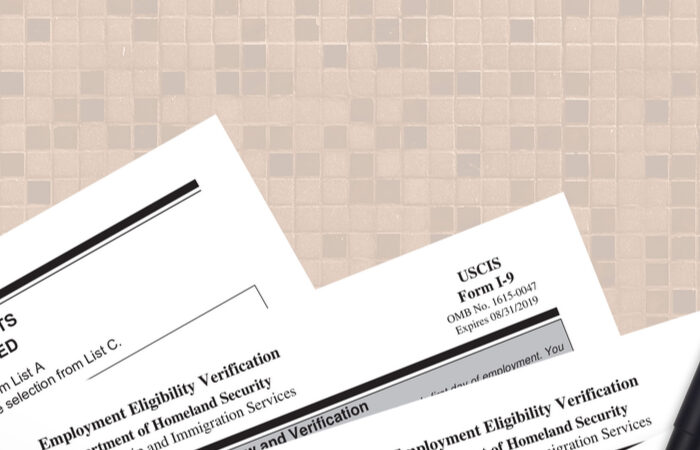A Helpful Guide to Surviving an I-9 Audit
Is there an I-9 audit in your future? Not necessarily, but if you employ workers who have emigrated to this country, it’s important to understand how to manage the I-9 audit process.
What is an I-9 audit?
An I-9 audit is when federal immigration officials review an employer’s Forms I-9 to make sure they are accurate, complete, and that all its employees have the proper work authorization. An audit may be triggered for various reasons, including random samples or reporting by ex-employees.
Certain business sectors are more susceptible to I-9 audits, such as food production. The audit can be conducted by either Immigration and Customs Enforcement (ICE) or Homeland Security Investigations (HSI).
While officials don’t need a warrant to conduct an I-9 audit, they do issue a Notice of Inspection at least three days prior to the audit. This gives you time to produce the Forms I-9, especially if they are stored offsite.You may be asked to send records for review, or the officials may visit the workplace to conduct the audit there.
The I-9 audit checklist
Let’s say you’ve been informed that officials will be conducting an I-9 audit. What do you need? To be fully prepared, you must have:
- A list of all current employees
- A list of employees terminated in the last three years
- Copies of all I-9 forms (electronic or physical) for current employees and those that were terminated within retention requirements
- Current version of form I-9
- An audit log
The I-9 audit process
 Collate all Forms I-9
Collate all Forms I-9
Employers need to check and ensure that there is an I-9 on file for each and every employee currently working for you in the U.S. You should also have a list of current employees that you do not have a form I-9 for. If you have any I-9s for non-employees that do work for your organization (for instance, volunteers or consultants), you should remove them from your file.
Next, you are going to prioritize the I-9s. The highest priority are current employees that have no Form I-9, as this poses the greatest risk and you need to verify their eligibility to work in the U.S. immediately. The next priority is to review current employees’ I-9s to make sure they have been completed thoroughly and properly. Finally, you should review the terminated employees’ I-9s.
 Collect missing Forms I-9s
Collect missing Forms I-9s
All employees hired on or after November 6, 1986 should have an I-9 on file. If they don’t, they need to be contacted and instructed to provide the proper documentation.
As an employer addressing those employees, you should apologize that the form was not collected at the beginning of employment. However, you need to explain that the form must be completed (under federal law) and that failure to provide the necessary documentation may lead to termination. Communicate with each employee individually – verbal or written, make sure to keep a copy of all communication in the Form I-9 audit file.
You should establish a date when employees need to provide the required documents – generally, they should have to bring them the next day they work. The documents should be originals, and when the necessary documents are available, the Form I-9 should be completed immediately. Use current dates for the form, even if the date of hire was years ago. Attach a note to the corrected form explaining that the I-9 was completed during the audit; this is crucial as it shows that you made an effort to be in compliance and were not wilfully breaking the law.
Once this has been completed and the Form I-9 added to the file, you can remove the employee from the audit list.
If an employee can’t find the required documentation, the USCIS lists certain “receipts” that can be used as a temporary replacement (generally for 90 days). If they fail to provide the necessary documentation within the given time frame, the employee needs to be terminated or put on a leave of absence. They may be able to work for you again once proof of eligibility to work in the U.S. has been provided.
 Audit current employees
Audit current employees
Buckle up, as this is the most difficult step.
The USCIS has various resources to help you complete this process properly and be in compliance. Keep these on hand as you go through the Forms I-9. As explained here, employers can only correct technical errors in Sections 2 and 3; errors in Section one must be fixed by the employee.
Separate your forms into two files – one of I-9s that were completed properly, and the second of those that contain errors.
Any changes should be clearly shown as a correction. Use a different colored ink, draw a line through incorrect information, and initial and date the changes to make sure it’s obvious.
Major errors, such as entire sections left blank or based on unacceptable documents, may require a new Form I-9 to be completed.
Each of the three sections has some common mistakes to look out for.
Section 1
- Incomplete or missing name, other names used (such as maiden name), address or date of birth.
- Missing A-number/USCIS Number after selecting “A Lawful Permanent Resident.”
- Missing A-Number/USCIS Number or Form I-94 admission number after selecting “An alien authorized to work until.”
- Missing signature or date.
- Failure to identify immigration status.
- Not checking the box “I did not use a preparer or translator” (if applicable).
Section 2
- Documents listed under the wrong column.
- Incomplete information for each document.
- Missing business title, name, or address.
- Missing date of employment/hire.
- Representative of the organization fails to sign and date form.
Section 3
- Failure to enter the date of rehire.
- Failure to enter an employee’s new name.
- Failure to sign and date your name in the form.
 Review errors and make Form I-9 corrections
Review errors and make Form I-9 corrections
Make a list of I-9s that have errors – this will be the audit log. It should contain the employees’ names, the errors, and the actions that were taken to correct those errors.
These are some of the most common errors:
- Missing information
- If in Section 1, the employee should fill in the missing information and initial and date with the current date
- If documents or signatures are missing in Section 2, a new I-9 is required
- If the hire date is missing, the employee should fill it in and initial and date with the current date
- If documents or signatures are missing in Section 3, a new I-9 is required
- Documents in Section 2 are in the wrong columns
- Strike through incorrect information and write in the correct information. Initial and date with the current date. Original wording should be legible.
- Documents do not match those listed on the I-9
- Complete a new form with the current date.
- Section 3 is incomplete
- This will be blank for most employees as it is only filled out when an employee is rehired or work authorization is reverified.
As you correct each form on the I-9, the corrections should be added to the Form I-9 log.
 Organize and correct terminated employee I-9s
Organize and correct terminated employee I-9s
Determine the Form I-9 retention period once an employee is terminated. Correct any errors for terminated employees using the same process as for current employees. If you are unable to correct an error (such as a missing employee signature), make a note in the audit log and on a note on the appropriate Form I-9.
 Document steps and amendments in the audit log
Document steps and amendments in the audit log
As you go through and correct the I-9s and add in missing ones, organize them and document all of your steps. Keep the audit documentation with the I-9s or in a separate file, but make sure it’s in a safe and secure location.
Simplifying I-9 audits: Services and Tools
Forms I-9 can be difficult to audit, but an effective digital solution and I-9 audit services can help you with I-9 compliance. From paper form digitization to ongoing I-9 management, Tracker I-9 Compliance is a user-friendly solution created by top-ranked immigration experts. To date, it has a perfect 20+ year record of zero client fines.
[bctt tweet=”Completing Form I-9 is a complex undertaking, and often violations occur unintentionally.” via=”yes”]




